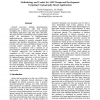Free Online Productivity Tools
i2Speak
i2Symbol
i2OCR
iTex2Img
iWeb2Print
iWeb2Shot
i2Type
iPdf2Split
iPdf2Merge
i2Bopomofo
i2Arabic
i2Style
i2Image
i2PDF
iLatex2Rtf
Sci2ools
ASAP
2007
IEEE
2007
IEEE
Methodology and Toolset for ASIP Design and Development Targeting Cryptography-Based Applications
Network processors utilizing general-purpose instruction-set architectures (ISA) limit network throughput due to latency incurred from cryptography and hashing applications (AES, DES, MD5, and SHA). This paper presents a methodology using computer-aided design, for development of high-performance application-specific instruction-sets (ASIP) targeting applications saturated in repetitive sequential bitwise operations and data-flow dependencies, thus exposing both fine and coarse grain parallelism through a set of recurring pattern extraction tools. These specific instructions, in conjunction with a minimal set of general-purpose instructions, are then incorporated into a simplistic, single-cycle CPU architecture, for a comparison (in CPU cycles) with common generalpurpose instruction latencies (Intel P4). We show that the high-performance instruction set derived, based on the proposed methodology, has the potential for facilitating dramatic improvements in performance (over the softwar...
ASAP 2007 | Coarse Grain Parallelism | General-purpose Instruction-set Architectures | Hardware | Repetitive Sequential Bitwise |
| Added | 18 Oct 2010 |
| Updated | 18 Oct 2010 |
| Type | Conference |
| Year | 2007 |
| Where | ASAP |
| Authors | David Montgomery, Ali Akoglu |
Comments (0)

